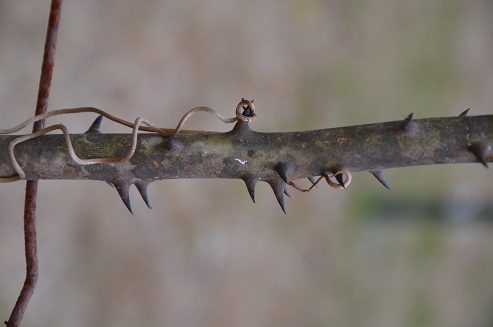
by Les Harrison | Feb 24, 2015

Smilax is noted for its multiple thorns which scratch anyone who comes into contact
The yo-yo thermometer readings make it confusing for the panhandle’s human residents when choosing proper wardrobe selections. With few exceptions, the deciduous plants and trees continue to wait for consistently warmer weather and longer days before covering their trunks and stems with foliage.
The current season’s uncloaking allows for easy examination of the structure and configuration of what will be green and hidden in a few months. This exposure also reveals potentially painful hazards in the native landscape.
Smilax, the sinewy vine, puts up an intimidating barrier to man and beast. Also known as green briar, cat briar and other sometimes graphic terms, the native plant thrives in this area.
In Greek mythology, Smilax was a wood nymph who was transformed into a bramble after the unfulfilled and tragic love of a mortal man. Her final form in this fable was a reflection of her character.
Botanically, smilax is found in tropic to temperate zones. There are about 350 species worldwide and 12 in Florida, with nine being common.
The plant is very vigorous and is equipped with an enviable array of survival traits. It is ready to take every advantage to flourish and inhabit new territory, even under the most unfavorable conditions.
Individual plants can withstand harsh treatment and environments. If burned or mowed to the soil’s surface, they will regenerate from a segmented rhizome root system. Rhizome roots are the subterranean stems which spread roots and runners from its bulbous root nodes.
If pulled up, the rhizome root system will separate at joints. Even the smallest piece of root left in the dirt will generate a new plant.
Smilax has the additional resource of extra-floral nectaries, nectar-producing glands physically separate from the flowers. These nectaries may function as an organ for the plant to rid itself of metabolic wastes and/or to attract beneficial insects for pollination and defense.
Ants are especially attracted to the extra-floral nectaries in smilax and frequently establish mounds close by. The ants defend the smilax from herbivores which eat the leaves, if they can get past the thorns.
In addition to spreading by its root system, smilax produces berries which contain a seed. The berries appear in late summer or early autumn and ripen to a blue-black color.
The berries are usually consumed in winter after the smilax loses it leaves. Birds and animals will deposit the seed at a new site. Best chances for the seed to germinate occur after it is exposed to a freeze, as the panhandle has recently experienced.
Smilax vines will climb up trees, fence post, and any other stationary object to get better sun exposure. They have been known to reach over 30 feet in height, but do not tend to kill their host by shading out the sun.
Ants commonly use the vines as a readily available pathway on foraging trips. Ants may establish colonies in above ground locations, courtesy of smilax vines which provide a wide-reaching pathway.
Smilax can be controlled with some broadleaf herbicides, but repeated applications will be necessary. The best time to apply herbicides is in the early spring when the first leaves appear.
Once the leaves return, smilax can be difficult to identify and control, hidden in all the common greenery.
To learn more about smilax in Panhandle Florida read the Key to Nine Common Smilax Species of Florida or contact your local UF/IFAS Extension Office.
by Mary Salinas | Feb 2, 2015
So often, homeowners wait until weeds have overtaken their lawns in mid-summer before looking for a course of action to control them. Unfortunately, when weeds get to maturity and start producing flowers and going to seed, they are usually quite difficult to control.
[important]The best strategy is to prevent the weeds from getting established in the first place![/important]
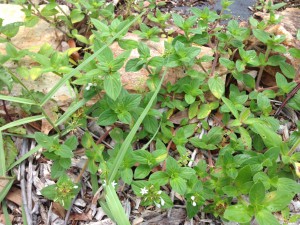
Florida pusley, an annual weed that can be controlled with preemergence herbicides. Photo credit: Mary Derrick UF/IFAS Extension.
When properly applied, a preemergence herbicide forms a chemical barrier on the surface of the soil that kills newly germinated seeds when they grow and contact that barrier. Be sure to follow label directions carefully as it is crucial to apply the correct amount and water it in correctly. The soil surface should not be disturbed after application to ensure that the chemical barrier remains intact.
Keep in mind that preemergence herbicides only prevent annual weeds! They do not control weeds that have already emerged.
In North Florida, the time to apply a preemergence herbicide to your turfgrass is coming soon. As a general rule, March 1 is an ideal time. Another indicator that the time is right is when the daytime temperatures reach 65°F-70°F for 4 to 5 consecutive days as that sustained warmth will prompt weed seeds to germinate. Oftentimes, this is also when azaleas or dogwoods start blooming and that can clue you into when to apply the herbicide. For best results, follow up with a second application in 6 to 9 weeks to control those seeds germinating later in the season.
Always follow the label instructions precisely when applying any herbicide! Ensure that you apply the product at the correct rate, that it is suitable for your specific turfgrass and situation, and that it is watered in correctly. For any pesticide, the label is the law!
If your lawn has problems with winter weeds, make a note on your calendar to apply a preemergence herbicide about October 1 in North Florida or when nighttime temperatures drop to 55°F-60°F for several consecutive days.
For more information on weed control in lawns:
Weed Management Guide for Florida Lawns
For general information on lawn care in Florida:
UF/IFAS Gardening Solutions: Lawns
by Larry Williams | Jul 15, 2014
Florida Betony (Stachys floridana), commonly called rattlesnake weed, is a Florida native plant. It’s thought to have been confined to Florida until it was moved to other Southeastern states during the 1940s or 1950s in nursery containers. It is now found from Texas to North Carolina. Its square stems are characteristic of the mint family of which it is a member.
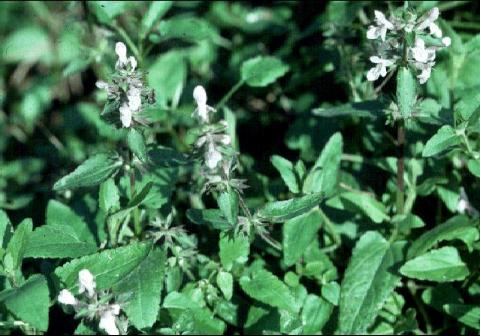
Florida Betony foliage & flowers Photo Credits: UF/IFAS Extension
Underground white, fleshy tubers, which resemble a rattlesnake’s rattle in shape, provide the main means of reproduction. Pinkish-purple flowers are followed by a dried fruit that splits open releasing tiny seeds, which are a lesser means of reproduction. The white tubers have been used for hundreds of years as a starchy vegetable and are sometimes boiled like peanuts.
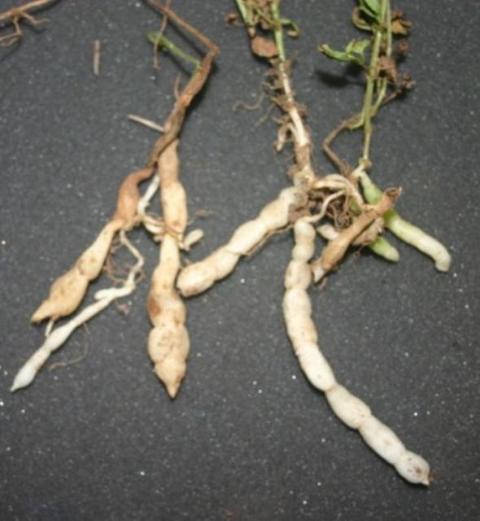
Florida betony weed tubers Photo Credits: UF/IFAS Extension
The tubers make Florida Betony tough to control. Even when above ground foliage and stems are killed due to herbicide use, the tubers allow the regeneration of the plant repeatedly. When attempting to control this weed, it helps to be more persistent than the plant. Many people give up.
Even though it is a perennial, the above-ground portion of the plant grows during fall and spring and becomes dormant during hotter weather.
You can remove the weed by digging, making sure to remove the entire root system (including the tubers). But persistence and patience is required. Herbicide control usually involves repeat applications approved products in lawns. Glyphosate herbicides such as Roundup can be used to control Florida Betony in plant beds. But do not get the herbicide on any green portion of desirable ornamentals.
Always refer to the product’s label for specific uses, application rates and turfgrass tolerance when using any herbicide.
So, why not just dig up the Florida Betony in your lawn and have a native plant feast?
by Larry Williams with content by Matthew Orwat
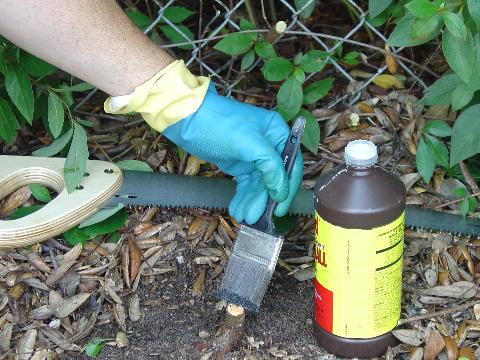
by Larry Williams | Jul 8, 2014
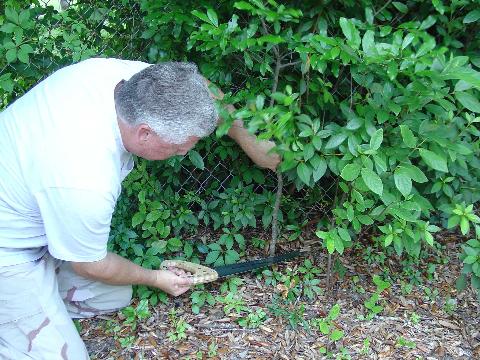
Making cut before herbicide application Photo Credits: Larry Williams & Sheila Dunning, Okaloosa County Extension Agents
Question: We planted Wisteria for its beautiful spring flowers and it grew and grew and took over everything. Now we’re trying to get rid of it. New plants are sprouting everywhere – up to ten feet away from the original plant. Is there a way to rid our landscape of this now wild plant?
Answer: Chinese Wisteria, Wisteria sinensis, can be a big problem to control. I’ve seen entire fields taken over by it. Yet, many people wonder why you would want to kill a beautiful plant like Wisteria. It’s possible to keep it in bounds for a while (possibly years) in the middle of a lawn with its new shoots arising from roots being routinely mowed. But in many cases, given enough time, shoots coming from roots will escape and then begin to take over – growing on adjacent property, climbing trees, etc.

Application of triclopyr herbicide to cut stump Photo Credits: Larry Williams & Sheila Dunning, Okaloosa County Extension Agents
In order to control an established vine, you must be persistent. Your best bet, outside of moving, is to use a “cut stump” treatment on the main plant and every shoot that sprouts. Use a herbicide that contains triclopyr. Some brand names include Enforcer Brush Killer, Ortho Brush-B-Gon, Ferti-lome Brush Killer-Stump Killer. Cut the main stem (trunk) as close to the ground as possible and as level as possible to facilitate application of the herbicide to prevent sprouting. It is critical to immediately apply the product to the freshly cut “stump.” Stumps that are not treated with the herbicide will sprout. Always follow label directions and precautions and be very careful to not get the product on adjacent desirable plants, including their roots.
Other invasive, undesirable woody plants can be controlled using this method such as Chinese tallow (popcorn tree), Chinese privet (Ligustrum sinensis) and Japanese honeysuckle (Lonicera japonica). For more information, view “Herbicide Techniques for Woody Plant Control”, from UF IFAS Extension .
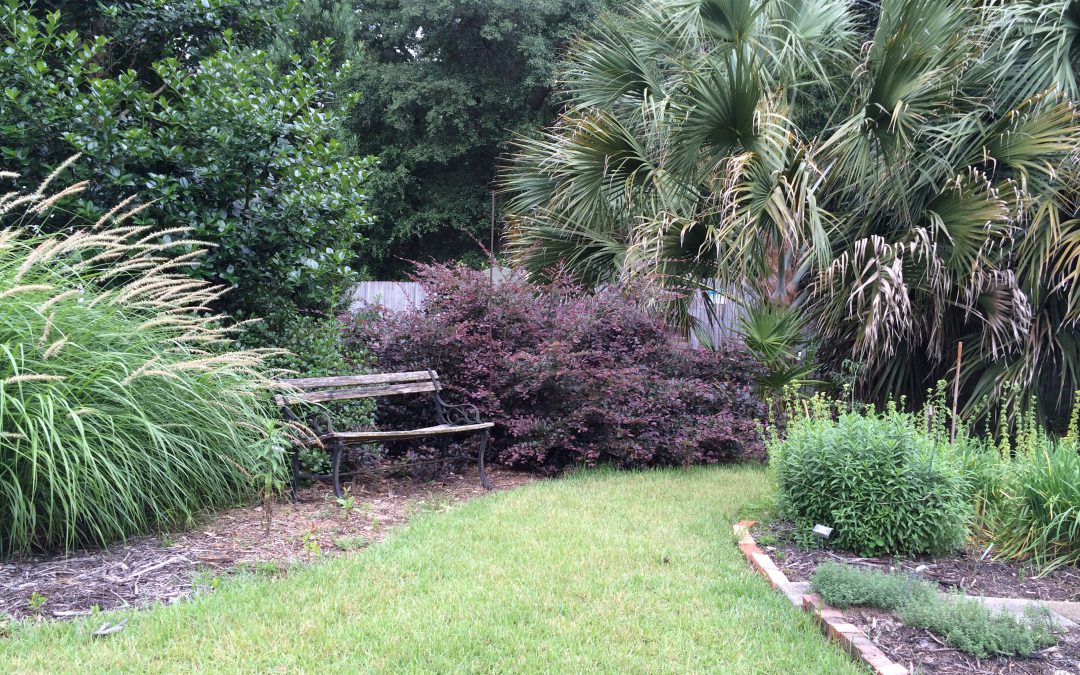
by Roy Carter | Jun 23, 2014
Summertime is vacation time for people, not plants! While getting ready for that long awaited trip, it’s easy to forget about your lawn, landscape, vegetable garden and house plants. A little time spent preparing your leafy friends for your absence could save you needless worry and hours of extra work when you get back.
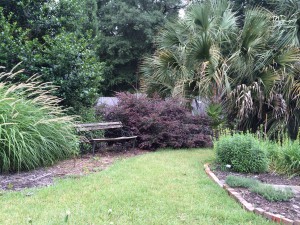
Prepare your landscape for your absence.
Photo by Mary Derrick, UF IFAS
A vacation may be relaxing and rejuvenating for you and your family, but it can be hazardous, even deadly, for your plants. Unless you make adequate preparations before leaving, you could return to vegetable disaster.
One of the first things you might do before leaving home is ask a neighbor to check your plants periodically while you’re gone. All plants need some care. During an extended vacation container grown plants require special attention and different species have different needs. Be sure you give your friend specific instructions for the care of each type.
If you can’t find someone to personally look after your plants while you’re away, there’s plenty you can do prior to departure to make sure you don’t come home to a limp landscape and sickly house plants. Outdoor container plants should be placed in a shady area to conserve moisture. Under a tree or on the north side of a building are good locations. A thick layer of mulch will help conserve moisture for landscape plantings. Mow your lawn just before leaving, cutting the grass a little closer than usual. An unkept lawn can encourage disease, and it’s a tell-tale sign that no one’s home.
Give lawn and landscape plants a heavy watering – especially recently planted beds, which will need extra moisture. Also, thoroughly spray or dust your plants to protect them from insects and diseases while you’re away. If you have flowering annuals, cut the blossoms before departing. If you don’t, they’ll soon stop blooming. Harvest all ripe or nearly ripe fruits and vegetables. Like flowers, they will continue to produce only if they’re picked frequently. Otherwise, they’ll go to seed.
Do a thorough job of weeding. If weeds are allowed to go to seed while you’re away, you can expect to encounter much more difficult problems later in the season – even next year – when the seeds sprout. Weeding eliminates a major source of competition for your landscape plants’ food and water which may be in short supply during your absence.
Plants kept indoors require special consideration. Before leaving home, place your house plants in a room which receives indirect sunlight. Direct exposure to the sun will dry the soil too quickly. Of course, you don’t want to put your plants in a room that’s too dark, either. Too little light will almost always result in leaf drop. And, just before you depart, be sure to water your house plants thoroughly. This is especially vital, because – unlike lawn grass and landscape ornamentals – house plants cannot benefit from any rain that may fall while you’re gone.
You’ll enjoy your vacation more by making sure your plants are well prepared for your absence.
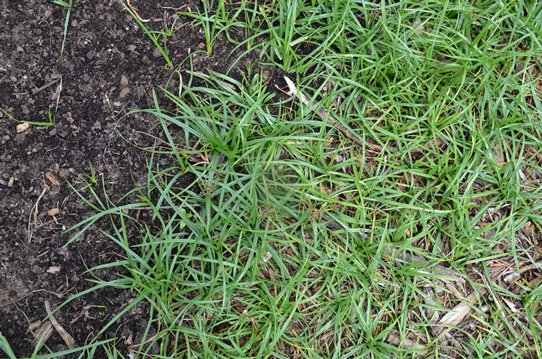
by Les Harrison | May 6, 2014

Purple Nut Sedge aggressively moves into any sunny open space and crowds out competitors.
The spring season in panhandle Florida is colorful. Every location from frequently manicured gardens to untended fields and pastures are exploding with hues and tones pleasing to the eye.
These heralds of the warmer weather to come are trailed by the warm season’s greenery which fills in the gaps between blooms. The consistent and ample rains have assured the continuance of a bright and pleasing landscape backed by countless shades and textures of green.
The adequate moisture has also assured the aggressive growth of an individually small, but collectively gigantic, weed which plagues every member of humanity associated with attempting to cultivate plants.
Purple nut sedge, Cyprus rotundus, has emerged en mass from every possible sunny location with soil. This native plant is a rapidly spreading perennial which will take every opportunity to colonize new locations.
The identifier purple is in the name because there is a purple-tinged section of this sedge where it emerges from the ground. The plant is sometimes referred to as purple nut grass because of its long narrow leaves and its erect growth pattern originate from a nutlike basal bulb.
There are other sedges in north Florida, but only yellow nut sedge is identified by a specific color. It is sometimes called chufa and is a popular feed for wild turkeys and turkey hunters.
The dark green, smooth leaves blend in easily with many turf grasses. Beneath the soil’s surface and out of sight, the root system grows in every direction.
Purple nut sedge’s roots are a series of spreading rhizomes and tubers or bulbs identified as nutlets. Each nutlet sprouts a new bunch of grass-like leaves and continues growing the rhizomes.
The densely population of this sedge quickly crowds out most other plants, but most especially turf and forage grasses. It can reach a height of 18 inches on its triangle shaped stem.
The root system’s design assures this plants survival and continued success. If pulled, the rhizomes break off leaving a large number of nutlets to develop and emerge at a later date.
If plowed or tilled, the nutlets are detached and spread to new and inviting locations. Many times nutlets lodge in tillage equipment only to shake loose and deposited in un-colonized locations.
Most herbicides have little on this sedge’s hardy root system. Selected pre-emergent herbicides will prevent many of the nutlets from germinating in spring.
North Florida’s sandier soils provide an ideal growing environment for purple nut sedge. The occasional periods of water saturation from storms do not deter this plant’s rapid and growth expansion to new areas, but it will not tolerate heavy shade.
Purple nut sedge’s extreme competitive nature is a heavy consumer of plant nutrients and robs rivals of important compounds necessary for their survival. Additionally, it produces an allelopathic substance which is toxic to some plants.
Purple nut sedge is found in many locales in North America where the environment is hospitable to its growth. The lush green leaves and touch of purple signify work for anyone who is maintaining a lawn or garden.
To learn more about purple nut sedge in north Florida contact your local UF/IFAS County Extension Office and read this informative publication on purple nutsedge.









